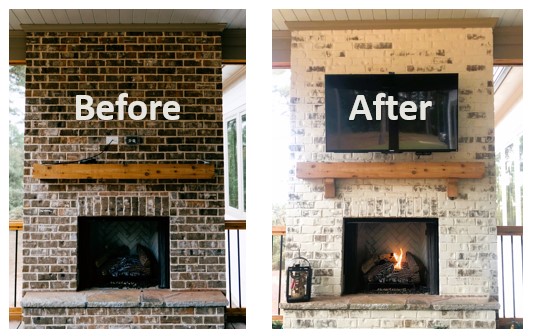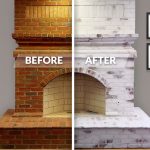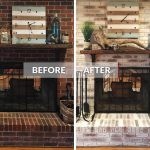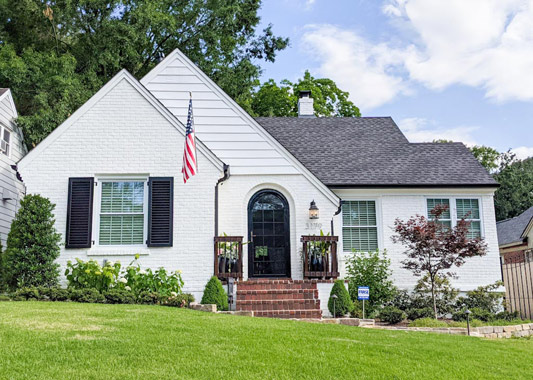You don’t need German-smeared mortar, hydrated lime, or synthetic paints to achieve the whitewashed brick look you’ve been imagining. And you definitely don’t have to settle for acrylic paint that looks unnatural with its shiny finish.
With the Romabio Fireplace Kit, you can transform your fireplace in just one afternoon. Classico Limewash is an authentic, slaked-lime paint imported from Northern Italy, the same material used for centuries throughout Europe. Whether you prefer the timeless character of an antique brick finish or a more modern, solid look, limewash provides beautiful results that are durable, breathable and unique.

Tools & Materials Needed:
- Romabio Fireplace Kit Includes
- 2.5L of Classico Limewash paint. (covers 200–250 sq. ft.)
- Small Masonry Brush
- Application Instructions
- Stir stick and bucket opener
- You may also need:
- Spray bottle filled with water
- Plastic or drop clothes for the floor
- Mixing bucket (2 gallon or 3–5 liters)
- Towels or rags (cotton towels or old dish rags work well)
Classico Limewash is specially formulated as a slow-set paint. That means you have plenty of working time to create a finish that feels right for your space, whether that’s a softer whitewash brick fireplace style or a heavier, opaque appearance.
Step-by-Step Application Guide
If you’re wondering how to limewash a brick fireplace, the process is simpler than you might think. Here’s a full limewash fireplace tutorial to get you started:
Step 1. Clean the brick
Before painting, you need to make sure the brick is clean. Use the old rags moistened with water to wipe down the surface and remove any cobwebs or soot.
Step 2. Dampen with water
Lightly mist the brick with a spray bottle. The surface should feel damp, not soaked. This helps the limewash absorb properly.
Step 3. Dilute the paint with water
Classico Limewash should be diluted with clean water at a ratio of 50–100%. For 1 quart of paint, mix with ½ quart to 1 quart of water. Start with less water first, then adjust as needed. Mix thoroughly in a bucket until the consistency is uniform, with no standing water.
Step 4. Apply with a brush
Starting in the top left corner, apply the limewash in sections, ensuring even coverage. Don’t worry if it looks streaky at first; that variation is part of the natural finish.

Step 5: Let It Set
Allow the paint to partially dry. Depending on the air temperature, this process may take anywhere from 15 minutes to several hours. The surface should be damp, not dripping.
Step 6: Spray and Wipe Back
This is where you create your custom look. Use the spray bottle and rags to remove as much or as little limewash as you want. This step exposes the brick underneath, allowing you to achieve anything from a subtle wash to a bold antique brick finish.

Step 7: Enjoy Your New Fireplace
Touch up areas as needed. If you’re not satisfied, remove limewash with household vinegar and reapply. Once fully dry, the limewash will calcify and harden. For extra protection and to prevent chalking, especially on stoops or ledges, apply a top coat of Romabio Mineral Shield.
Bonus: The same technique works outdoors. For exteriors, swap the spray bottle for a garden hose to achieve an easy, old-world finish reminiscent of historic European architecture.
Tips to Get the Perfect Look
- Test first. Try your mix on a small area before committing to the entire fireplace.
- Control the dilution. More water means more transparency; less water gives a solid, painted effect.
- Feather the edges. Blend sections with a damp rag for a natural-looking variation.
- Work in sections. Stay consistent, especially if you’re aiming for a softer limewash versus a whitewash style.
Limewash vs Whitewash
It’s common to confuse limewash vs whitewash, but there is a clear difference:
Whitewash uses diluted latex or water-based paint to coat the surface with an opaque layer. It can look flat and tends to peel over time.
Limewash is a mineral-based product that penetrates the brick, enabling it to breathe. It gradually develops a soft patina over time and can be adjusted during application to achieve a fully customized finish.
If you want authentic texture, variation and lasting durability, limewash is the better choice.
FAQ
Is limewash breathable?
Yes. Classico Limewash allows moisture to pass through masonry, making it suitable for both interior and exterior applications.
How long does limewash last on a fireplace?
Indefinitely. Since indoor fireplaces aren’t exposed to rain or weathering, the finish is long-lasting.
Can I limewash over painted brick?
No. Limewash only adheres to porous, unpainted surfaces.
What if I want to change the look later?
You can easily adjust the finish during the application process. Even after it dries, you can remove it with vinegar and reapply.
The Bottom Line
Transforming a fireplace is about more than just a coat of paint. With Romabio’s Classico Limewash, you get an authentic, mineral-based finish that showcases the natural beauty of brick, creating a timeless, durable look that is uniquely yours . Whether you prefer the character of an antique finish or the sleek style of a modern wash, limewash offers you flexibility and lasting results.
When you’re ready to take the next step, Romabio makes it simple to bring your vision to life with products that are easy to use and trusted by homeowners and pros alike.
Start Your Project Today
Find a PRO – Work with contractors who know how to apply Romabio limewash for a fireplace finish you’ll love.
Find a Store – Enter your zip code to locate retailers carrying Romabio products, including options to tint to your perfect shade.
Let Romabio help you turn your fireplace into the centerpiece of your home, combining historic charm with modern style in a stylish finish that will last for years to come.








 Photo Credit: Caldwell House, TN
Photo Credit: Caldwell House, TN